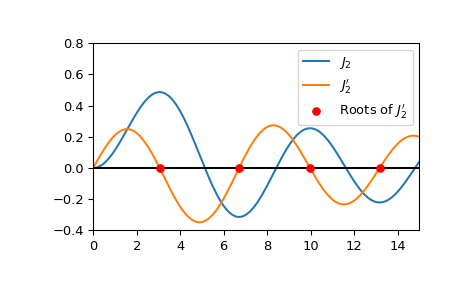scipy.special.jnp_zeros#
- scipy.special.jnp_zeros(n, nt)[source]#
Compute zeros of integer-order Bessel function derivatives Jn’.
Compute nt zeros of the functions \(J_n'(x)\) on the interval \((0, \infty)\). The zeros are returned in ascending order. Note that this interval excludes the zero at \(x = 0\) that exists for \(n > 1\).
- Parameters:
- nint
Order of Bessel function
- ntint
Number of zeros to return
- Returns:
- ndarray
First nt zeros of the Bessel function.
See also
References
[1]Zhang, Shanjie and Jin, Jianming. “Computation of Special Functions”, John Wiley and Sons, 1996, chapter 5. https://people.sc.fsu.edu/~jburkardt/f77_src/special_functions/special_functions.html
Examples
Compute the first four roots of \(J_2'\).
>>> from scipy.special import jnp_zeros >>> jnp_zeros(2, 4) array([ 3.05423693, 6.70613319, 9.96946782, 13.17037086])
As
jnp_zerosyields the roots of \(J_n'\), it can be used to compute the locations of the peaks of \(J_n\). Plot \(J_2\), \(J_2'\) and the locations of the roots of \(J_2'\).>>> import numpy as np >>> import matplotlib.pyplot as plt >>> from scipy.special import jn, jnp_zeros, jvp >>> j2_roots = jnp_zeros(2, 4) >>> xmax = 15 >>> x = np.linspace(0, xmax, 500) >>> fig, ax = plt.subplots() >>> ax.plot(x, jn(2, x), label=r'$J_2$') >>> ax.plot(x, jvp(2, x, 1), label=r"$J_2'$") >>> ax.hlines(0, 0, xmax, color='k') >>> ax.scatter(j2_roots, np.zeros((4, )), s=30, c='r', ... label=r"Roots of $J_2'$", zorder=5) >>> ax.set_ylim(-0.4, 0.8) >>> ax.set_xlim(0, xmax) >>> plt.legend() >>> plt.show()
